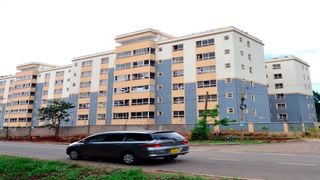
High-rise apartments in Kileleshwa in Nairobi on January 7, 2020. Residential areas such as Kilimani, Lavington and Kileleshwa have seen an increase in the construction of high-rise apartments for either residential or commercial purposes.
| File | Nation Media GroupNairobi
Premium
Troubled paradise: The changing face of Nairobi's Kileleshwa and Kilimani
What you need to know:
- Uncontrolled development in these neighbourhoods is still a common sight.
Governor Johnson Sakaja says developers put up buildings of up to 15 floors instead of the stipulated fourth-floor limit.
In the heart of Nairobi's urban landscape, the neighbourhoods of Kilimani and Kileleshwa, stand as testaments to unchecked growth. Towering structures, seemingly born overnight, have transformed these once-serene residential estates into concrete jungles.
As modern towering edifices cast shadows over old-fashioned homes, serious questions arise about infrastructure strain, environmental impact, and community identity.
This lush, idyllic region on the northwest part of Nairobi, was a place known for its beauty and serenity featuring leafy suburbs long before a massive construction broke out around the mid-2000s.
As of 2021, the Nairobi County government ramped up various measures to abate these massive constructions including, revising zoning and planning regulations, to ensure that new developments align with the area's intended land use.
However, uncontrolled development in these neighbourhoods is still a common sight.
In a recent media interview, Nairobi Governor Johnson Sakaja revealed that his administration was embroiled in a court tussle with 735 landlords from posh estates of Kilimani and Kileleshwa over irregular implementations of the housing metrics.
According to Mr Sakaja, the developers put up buildings of up to 15 floors instead of the stipulated fourth-floor limit.
Amid the relentless rise of concrete giants, discontent rises from the long-time residents of these regions. Their stories etched with nostalgia, they bemoan the fading charm of sunlit streets, replaced by shadows of towering structures. The soul of these neighbourhoods, once serene, now echoes with the cacophony of concerns—straining infrastructure, dwindling green havens, and eroding community identity.
“In the long term, this is going to have serious repercussions,” warns David Njunguna of the Kilimani resident’s association when he spoke to NTV in February.
In recent years, the residents have become increasingly active online, wielding their smartphones as weapons of expression while documenting new constructions in their neighbourhoods. In this digital gallery of grievances, Most photos and videos posted on social media, capture the creeping giants of construction.
Back to the future
During British colonial rule, a class system emerged in Kenya, dividing society into the ruling class, middle class, and lower class. This division significantly influenced Kenyan culture and urban development, particularly in Nairobi.
The city's west of Uhuru Highway was designated for ordinary Kenyans, while the east, including Kilimani and Kileleshwa, was reserved for white settlers. These areas earned the nickname "leafy suburbs" due to their spacious homes on vast tracts of land.
After independence in 1963, Nairobi's upscale neighbourhoods retained their low-density character, marked by large residential plots and plenty of open space. Rapid urbanisation, however, led to challenges like uncoordinated growth and inadequate infrastructure.
In 1987, urban planning policies introduced zoning, categorising properties into different zones for controlled development. Estates in Nairobi East, such as Kileleshwa and Kilimani, were placed in Zone 4, allowing denser development over time.
Nairobi's population has since steadily grown, reaching 4.73 million in 2020, with an estimated five million by 2025. While the city's planning still reflects its colonial-era layout, changes in zoning have led to the rise of apartment buildings in Zone 4, driven by a high demand for housing.
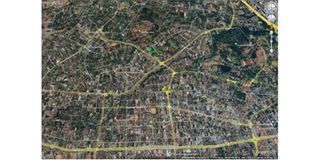
A Google Earth Satellite view of Kilimani and Kileleshwa estates.
Satellite imagery reveals the rapid infrastructural changes in Kileleshwa and Kilimani, between 2014 and 2022. The bird’s eye view images paint a picture of the transformation within these neighbourhoods.
In 2014, the areas were predominantly residential with low-rise buildings and abundant green spaces. Fast forward to 2022, the satellite images reveal the skyline is now dotted with high-rise buildings, indicating a shift towards vertical expansion.
Increased connectivity within and between these neighbourhoods is also evident as new roads are visible from above. The expansion of commercial spaces such as shopping malls and office complexes is evident as well.
Moreover, the satellite images show a gradual reduction in green spaces, replaced by concrete structures. This transformation reflects the chronological scales at which these two estates have massively transformed.

A timelapse showing the changes in Kilimani and Kileleshwa between 2014 and 2022.
Tracking down the changes on the ground
To analyse this tale of urban evolution, theNation used the lens of two YouTube videos that recently showcased the towering edifices in Kilimani and Kileleshwa. Through pixels, these videos became windows into the past and present, allowing our investigation to stitch together the fabric of the growing neighbourhood.
In Kileleshwa for instance, the physical manifestation of this urban habitat transformation is evident at various levels: the street network, the plots, and the buildings. Tracing its roots from 2014 to 2022, there has been a variation in transformation across these levels, resulting in an increased density of the urban habitat.
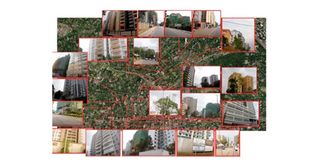
Screengrabs of newly constructed apartments in Kileleshwa from a YouTube vlog showcasing the estate.
Kilimani, which was equally once a quiet suburb, has been dramatically transformed by new construction. The skyline, once dominated by single-story homes and lush greenery, is now punctuated by towering apartment complexes and commercial buildings.
This shift in architectural landscape has brought about a change in the neighbourhood’s character, attracting a diverse mix of residents and businesses.
However, this rapid development has also led to increased strain on infrastructure. Despite these challenges, Kilimani seemingly continues to evolve, reflecting the broader urbanisation trends in Nairobi.
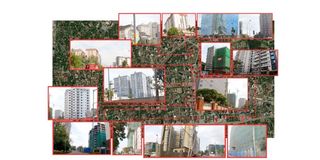
Screengrabs of newly constructed apartments in Kilimani from a YouTube vlog showcasing the estate.
Earlier this year, the Nation reported how the once leafy suburb estate is fast turning into Nairobi's new 'slums', this report further highlighted how the growing population is putting a strain on the existing amenities.
We further verified commercial advertisements for more than 30 new highrise apartments in Kilimani and Kileleshwa estates between 2019 and 2023.
The influx of residents has cast a shadow over the charm of these neighbourhoods, straining their once-effortless amenities. "It's like we've outgrown our oasis," laments one resident, highlighting the growing congestion on once peaceful streets.
As these neighbourhoods grapple with urban growth, the delicate balance between preserving their allure and accommodating new inhabitants remains a challenge.

Through Google Streetview in Kileleshwa, the Nation discovered the modern-story building under construction with 21 floors, as opposed to the set limit of 4 floors.
This growth has generated considerable controversy because on one hand the long-serving residents affected by urban planning policies strongly believe this area should be reserved while on the other the county government believes this is a remedy to the housing problem in the city.
Criticism has been directed at the Nairobi county government for its inability to handle unbridled constructions. The absence of a decisive approach to confront the issue has provided an opportunity for unethical developers to persist in building high-rise informal settlements without adherence to legal regulations.
Mr Sakaja has in the recent past expressed concerns, stating, “Despite established construction guidelines, most developers contravene these parameters and persist with their construction activities.”
Urban sprawl has occurred largely because land owners and developers have made choices that promote their own economic and personal interests, which do not necessarily coincide with the public good.
The uncontrolled development of highrise apartments in the Kilimani and Kileleshwa areas is now putting a strain on the available amenities. Some flat owners pointed out their buildings had experienced extensive flooding, cracks and even falling cladding since a further five flats were built on top.
Trees cut for more houses
At the heart of urban evolution, Kileleshwa and Kilimani bear witness to a shifting landscape where the pressing demands of population growth and expansive construction threaten the very essence of green spaces.
As these neighbourhoods burgeon with residents and soar with towering structures, the serenity of open spaces fades like a distant memory.
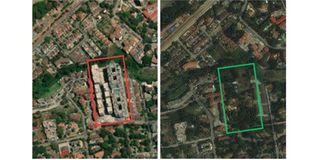
New infrastructure in Kileleshwa estate, the Nation established its construction began in 2017 (right), image via ESRI.
The symbiotic relationship between concrete and greenery is strained. Towering buildings now rise where trees once stretched their branches, while the increasing human footprint engulfs what were once tranquil gardens. The demand for housing and infrastructure supersedes the preservation of vital green lungs.
"Green spaces are vanishing before our eyes," laments George Nyagah, a concerned member of the Kilimani residents association, while speaking during an interview with NTV, noting the stark reality that urbanisation and population growth are leaving little room for nature's respite.

The same area within years apart shows new highrise buildings put up in once-green spaces. Imagery via Google Earth.
The challenge lies in harmonising the burgeoning needs of a growing population with the imperative to sustain these precious pockets of nature. In a delicate dance between growth and preservation, Kileleshwa and Kilimani strive to reclaim the balance that nurtures both humanity and the environment.
However, Mr Sakaja affirms, "Our county government is taking steps towards the 10 per cent greenery policy. We need spaces for trees and recreation. Where setbacks apply, we'll create pedestrian paths and cycling lanes, providing areas for walks and jogs."
Social media for environmental justice.
Social media platforms have since become the area’s part of sharing news about the latest developments in the area. The locals feel that significant concerns aren't given the weight it deserves; issues such as water pollution and conflict in the environment.
Since 2016, online users have posted pictures of the dilapidated Kirichwa Kubwa River that goes through their neighbourhood; these photos are coupled with complaints about stench and solid waste disposed within the river.
As Kileleshwa and Kilimani experience an influx of residents, the Kirichwa River faces a mounting challenge. The growing population strains the river's capacity to cope with increased waste and runoff. "The river's health is deteriorating," warns George Nyagah, citing rising pollution levels.
As concrete sprawls replace green spaces, rainwater rushes over impermeable surfaces into the river, causing erosion and flooding. The river, once a lifeline for the local ecosystem, is now under threat due to increased human activities.
Kirichwa River flows through the Kileleshwa and Kilimani neighborhoods. Imagery via Google Maps.
In 2016, more reports surfaced about raw sewage from the State House emptying into the Kirichwa River in Kileleshwa, a situation which went on for several months and infuriated residents along Githunguri Road who share the river’s riparian path with State House.
Similar complaints are still prominent. A further oil spill was observed in the same river in April 2023. Here oil waste or other pollutants are visible within the Kirichwa River that passes next to a petrol station.
The heavy pollution Kirichwa River has been of greater prominence for several years, with several organisations facilitating its restoration. Their campaigns have been pegged on addressing the need to keep the river which runs dozens of kilometers long clean.
But open source research also points to another, unseen source of pollution of the Kirichwa River — this time, from above the water’s surface.
The Nation examined Bing Maps satellite imagery which unveiled the distressing reality of Kirichwa River's pollution within Kilimani and Kileleshwa. From above, the images starkly showcase the contamination of the river, highlighting the environmental impact of urban growth on these neighbourhoods' vital waterways.

Imagery from Bing Maps shows a dumpsite adjacent to the brown Kirichwa River.
The sources of these reported waste disposals seem to originate near the various adjacent households improperly disposing of garbage into the river. The images starkly illustrate the dire consequences of irresponsible waste management on this vital waterway.
Sewage, all around.
The rapid transformation of Kileleshwa and Kilimani is a tale of two sides—on one hand, the surge in population and unceasing construction has brought dynamism, yet on the other, it's painted a canvas of infrastructure inadequacies and environmental challenges.
The outstretched infrastructure struggles to keep pace with the burgeoning demands, leaving residents navigating the urban maze with frustration. In a post on Twitter from March 2023, one activist complained about the smell emanating from a sewage pipeline discharging into the Kirichwa River.
Judging by media and social media reports, problems with wastewater spillage have continued ever since massive constructions began. Bursting sewage systems are an all too common sight, an aftermath of the surge in residents overwhelming the capacity of the ageing networks.
Moreover, with every rain, Kilimani and Kileleshwa become battlegrounds against flooding.
Concrete-covered grounds thwart natural absorption, diverting rainwater into overburdened drainage systems that cannot cope. Homes and roads stand vulnerable, enduring water's unwelcome embrace.
The fight continues
As urban landscapes continue to evolve, the confluence of population growth and massive construction within the Kileleshwa and Kilimani estates holds a trajectory that is poised to continue in the coming years. According to urban planner, Constant Cap, "These neighbourhoods' prime locations and desirability for both residents and developers make them magnets for growth. As long as urbanisation trends persist, so will the upward trajectory of these areas."
The allure of these neighbourhoods as desirable living spaces, combined with their strategic positioning within Nairobi, acts as a catalyst for continuous construction. Cap emphasises, "The upward trend in population migration to urban centres and the demand for modern living spaces will undoubtedly fuel this growth."
However, Cap also emphasises the need for foresight in urban planning. "The Nairobi County government should be proactive in crafting comprehensive development plans that encompass infrastructure, amenities, and environmental considerations." Proper zoning regulations, updated infrastructure, and measures to address environmental challenges are imperative to ensure the harmonious evolution of Kileleshwa and Kilimani.





